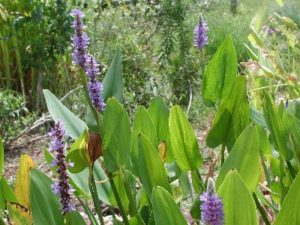
Pontederia cordata
Non-Herbicide Management Options
1. Physical Management Options
Pickerelweed can be cut, and the rhizomes can be dug up. However, physical control is difficult because it can re-establish from seeds and remaining rhizomes.
2. Biological Management Options
At this time, there are no known biological controls for pickerelweed; although, goats are known to forage on many types of emergent vegetation.
Herbicide Control Options
Always read the product label for directions and precautions, as the label is the law. Click on the name of the product to see the label. Read the label for specific water use restrictions.
The active ingredients that have been successful in treating pickerelweed include:
- Diquat (Rated: Good)
- Imazamox (Rated: Excellent)
- Imazapyr (Rated: Excellent)
- Tricolpyr (Rated: Good)
- 2,4-D (Rated: Good)
These rating are based upon the U.S. Army Corps of Engineers aquatic herbicide trials.
1) Diquat
Diquat is a contact algaecide and herbicide. Contact herbicides act quickly and kill all plant cells they come in contact with.
Common trade or product names include but are not limited to:
2) Imazamox
Imazamox is a broad spectrum, systemic herbicide. Systemic herbicides are absorbed and move within the plant to the site of action. Systemic herbicides tend to act more slowly than contact herbicides. An aquatically registered surfactant (a substance that will release the surface tension) is needed for application.
Common Trade of product names include but are not limited to:
3) Imazapyr
The active ingredient, imazapyr, inhibits the plant enzyme AHAS (acetohydroxyaced synthase). Habitat is a systemic herbicide that is effective on post-emergent floating and emergent aquatic vegetation. Imazapyr is effective at low-volume rates and does not contain heavy metals, organochlorides or phosphates, making it safe to humans and livestock. Habitat requires the use of a spray adjutant when applying on post-emergent vegetation.
Common trade or product names include but are not limited to:
4) Triclopyr
Liquid triclopyr formulation is a selective broadleaf, systemic herbicide. Systemic herbicides are absorbed and move within the plant to the site of action. Systemic herbicides tend to act more slowly than contact herbicides. An aquatically registered surfactant (see the label) will improve the effectiveness of triclopyr.
Common trade or product names include but are not limited to:
5) 2,4-D
2,4-D compounds are systemic herbicides. Systemic herbicides are absorbed and move within the plant to the site of action. Systemic herbicides tend to act more slowly than contact herbicides.
Common trade or product names include but are not limited to:
Precautions
One danger with any chemical control method is the chance of an oxygen depletion after the treatment caused by the decomposition of the dead plant material. Oxygen depletion can kill fish in the pond. If the pond is heavily infested with weeds, it may be possible (depending on the herbicide chosen) to treat the pond in sections and let each section decompose for about two weeks before treating another section. Aeration, particularly at night, for several days after treatment may help control the oxygen depletion.
One common problem in using aquatic herbicides is determining area and/or volume of the pond or area to be treated. To assist you with these determinations see SRAC #103 Calculating Area and Volume of Ponds and Tanks.
Many aquatically registered herbicides have water use restrictions (See General Water Use Restrictions).
To see the labels for these products click on the name. Always read and follow all label directions. Check label for specific water use restrictions.
Cultivation Options
Pickerelweed can be propagated by collecting the seeds and planting them in moist soil or transplanting the whole plant with rhizomes into moist soil areas during the early spring.
Questions?
If you need assistance, contact the Ag & Natural Resources agent in your county or hire a professional.